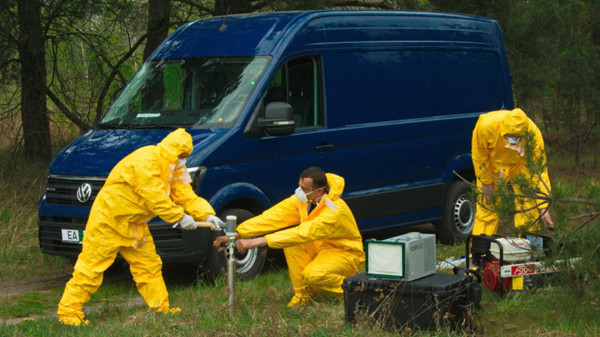IAEA equips Belarus with mobile radiation monitoring lab
The International Atomic Energy Agency (IAEA) has provided Belarus with a mobile laboratory for assessing radiological threats associated with forest fires in the Polessie State Radio-Ecological Reserve, adjacent to the Chernobyl Exclusion Zone. Recent fires in the exclusion zone did not lead to a hazardous increase in air-borne radioactive particles.

Crew of the new mobile laboratory on a practical training exercise for soil and air sampling in the Chernobyl Exclusion Zone (Image: Polessie State Radio-Ecological Reserve)
Forest fires are recurring events in the exclusion zone around the Chernobyl nuclear power plant in Ukraine, a 4760 square-kilometre (1838 square-mile) area surrounding the plant, mainly uninhabited since the accident there in 1986. The zone borders a separately administered area, the Polessie State Radio-Ecological Reserve, to the north, in Belarus.
In the event of forest fires in these contaminated areas, "sound scientific data is needed to ensure the appropriate response and protect the health of the public and of directly affected personnel, such as firefighters, forest workers, border guards, scientists and technicians working in the zone", the IAEA said.
Responding to Belarus' request, the IAEA assisted in designing and procuring a mobile laboratory, complete with instruments and tools for the radiation monitoring of air and the environment. The mobile laboratory is capable of off-road operations and serves as a work platform for a crew of four in the field. It is equipped with a portable air sampling device, a handheld gamma-spectrometer, a radiation monitor for environmental sample measurements, a soil sampling kit, personal protection garments, navigation and communication tools, an electric generator and a workplace with a computer and other appliances.
"The dedicated work of IAEA specialists and Belarusian counterparts allowed the design and delivery of a well-equipped and fit-for-purpose mobile laboratory to support Belarus in prompt response to contemporary radiological threats due to forest fires in the Chernobyl Exclusion Zone," said Peter Swarzenski, acting director of the IAEA Environment Laboratories.
The air samples collected at forest fire sites need to be analysed to accurately determine the activity of the radioactive isotopes of caesium, strontium and transuranium elements, the IAEA noted.
These activities are taking place as part of a technical cooperation project, launched in 2018, which was primarily focused on helping the scientific and technical staff of the Polessie State Radio-Ecological Reserve to advance their professional knowledge and skills. In particular, these relate to the dosimetry of inhalation intake of radionuclides, and to the identification and procurement of appropriate instruments, tools and consumables for radiation monitoring, air and soil sampling, sample processing and measurements.
The IAEA noted that its technical cooperation project with Belarus is now approaching completion and the country is now well equipped to assess radiological threats that may arise from forest fires in the future.
"Training activities, scientific visits, procurement of necessary equipment, supplies, as well as a mobile radiological laboratory were a significant contribution of the IAEA to strengthening our activities in the fields of research and radioactive pollution monitoring," said Mikhail Patsiomkin, chief specialist at Belarus' Ministry for Emergency Situations. "This is just what we need in this period."
Researched and written by World Nuclear News
- China Institute of Atomic Energy
- Nuclear Power Institute of China
- Southwestern Institute of Physics
- China Nuclear Power Operation Technology Corporation, Ltd.
- China Nuclear Power Engineering Co., Ltd.
- China Institute for Radiation Protection
- Beijing Research Institute of Uranium Geology (BRIUG)
- China Institute of Nuclear Industry Strategy (CINIS)
- China Nuclear Mining Science and Technology Corporation


